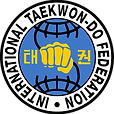
INTERNATIONAL TAEKWON-DO FEDERATION (TRADITIONAL)

Traditional ITF Tul
Patterns, or tul (틀) in Korean, originally called hyeong (형), form an important aspect of training in Taekwon-Do. They are equivalent to the kata in karate. The majority of the patterns (except Yul-Gok, Ul-Ji and Tong-Il) start with a defensive move, which emphasizes Taekwon-Do's defensive nature. All of the patterns start and end at the same location. This ensures that the practitioners' stances are the correct length, width, and in the proper direction. Additionally, students are taught to understand the purpose of each movement and recognize how each motion connects to theories of power.
There are 24 patterns in the official ITF syllabus; this is symbolic of the 24 hours in a day. One additional pattern, Ko-Dang (or Go-Dang), was retired/replaced by Juche in 1986 by General Choi Hong Hi. The names of these patterns typically refer either to events in Korean history or to important people in Korean history. Elements of the patterns may also be historical references, such as the number of moves, the diagram, the way the pattern ends, and so on.
Patterns (tul) are performed in accordance with "The Encyclopedia of Taekwon-Do" in 15 volumes written by General Choi Hong Hi, the latest edition being from 1999 (later editions have been published, but the 1999 editions were the last General Choi Hong Hi was directly involved with). This comprehensive work contains 15 volumes with volumes 8 to 15 dedicated to the 24 patterns and containing descriptions of the pattern movements as well as pictures showing possible applications of some of the movements. There is also the book entitled "The Korean Art of Self Defense" (the 1999 edition, the latest used by ITF under Chang Ung), also known as the Condensed Encyclopedia, written by General Choi Hong Hi. This is a single condensed encyclopedia of approximately 770 pages with a section dedicated to the 24 original patterns.
There are also three fundamental exercises, named Saju Jirugi (Four Direction Punch), Saju Makgi (Four Direction Block) and Saju Tulgi (Four Direction Thrust). Saju Jirugi and Saju Makgi are basic defence exercises taught to beginners of the martial art. Saju Tulgi is less well known and is generally taught to 2nd Kup students just prior to Hwa-Rang. Saju Tulgi is not presented in the Condensed Encyclopedia but is present in the 15 Volume Encyclopedia (see: Volume 10, page 122).
-
ITF Pattern 1 – Chon-Ji
-
ITF Pattern 2 – Dan-Gun
-
ITF Pattern 3 – Do-San
-
ITF Pattern 4 – Won-Hyo
-
ITF Pattern 5 – Yul-Gok
-
ITF Pattern 6 – Joong-Gun
-
ITF Pattern 7 – Toi-Gye
-
ITF Pattern 8 – Hwa-Rang
-
ITF Pattern 9 – Choong-Moo
-
ITF Pattern 10 – Kwang-Gae
-
ITF Pattern 11 – Po Eun
-
ITF Pattern 12 – Gae-Baek
-
ITF Pattern 13 – Eui-Am
-
ITF Pattern 14 – Choong-Jang
-
ITF Pattern 15 – Juche
-
ITF Pattern 16 – Sam-Il
-
ITF Pattern 17 – Yoo-Sin
-
ITF Pattern 18 – Choi-Yong
-
ITF Pattern 19 – Yong-Gae
-
ITF Pattern 20 – Ul-Ji
-
ITF Pattern 21 – Moon-Moo
-
ITF Pattern 22 – So-San
-
ITF Pattern 23 – Se-Jong
-
ITF Pattern 24 – Tong-Il